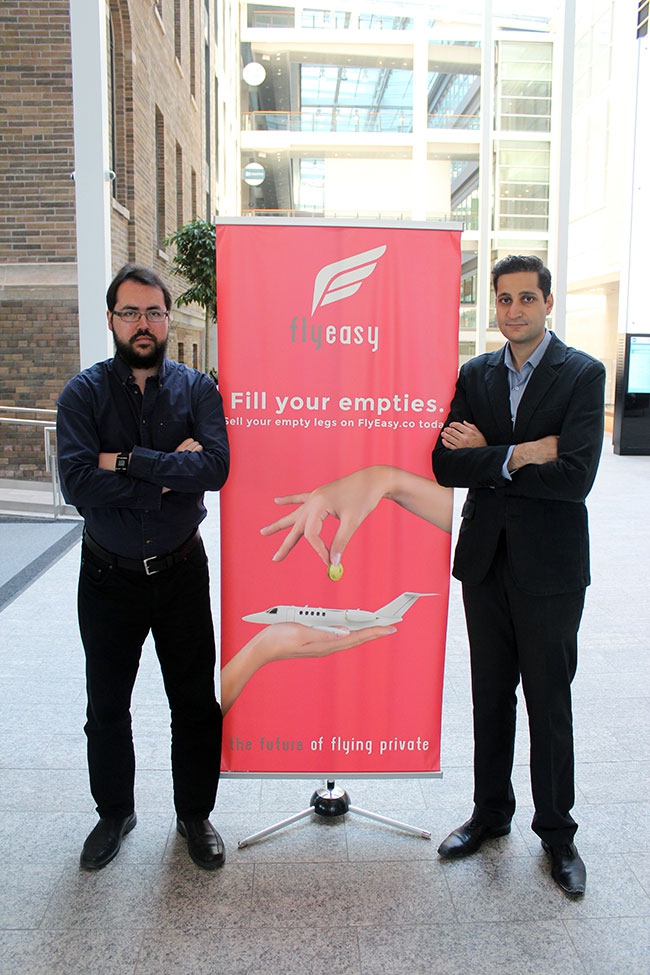
News
Alternate Approach: Amputating empty legs
Empty legs are an industry headache. It is estimated that in any given year, at least 33 per cent of Canada’s private jet capacity flies empty. This is the accumulative effect of having to reposition aircraft or return airplanes to base; both without passengers. It is likely a lowball estimate. Whatever the exact number, empty legs are a drain on charter operators who already fly on thin margins and need to maximize the utilization of fleets. They are also a drag on private jet owners who have invested big on multi-million dollar pieces of high-end machinery, and would like to see greater returns on investment (ROIs).
May 5, 2015 By David Carr
 It ain’t exactly Uber for the air Empty legs are an industry headache. It is estimated that in any given year
It ain’t exactly Uber for the air Empty legs are an industry headache. It is estimated that in any given yearTucked in the corner of an energetic, brick-walled communal office inside of Toronto’s MaRS building – a sprawling incubator for innovative start-up businesses – two entrepreneurs have founded FlyEasy, a technology-based company aimed at reducing the number of times a private jet flies empty by simplifying the connection between prospective customers and inventory. It ain’t exactly Uber for the air, but it does have the potential to revolutionize business travel the same way the plucky, hi-tech “rent-a-ride” service is changing how we hail a cab.
Empty legs are the biggest problem facing charter operators, says Shaan Bhanji, a FlyEasy co-founder and chief executive officer. “It is money left on the table and it isn’t a problem easily solved with existing scheduling and inventory systems, most of which were developed in the early 2000s.”
Bhanji, who had gained insight into the fractional sector by working with industry giant NetJets while he was a project manager for Bombardier, teamed up with Konstantin Filatov (FlyEasy’s chief technological officer), a technology specialist and software builder to develop a system that would push available inventory, including round trips and one ways, out to potential customers automatically and in real time complete with pricing and repositioning options.
Prior to that, most callouts for empty legs were done either by brokers over the telephone or cumbersome emails that contained long lists of available inventory. “The biggest problem with empty leg blasts and empty leg updates is that each email contains a lot of empty legs that are not necessarily relevant to the person who is receiving it,” Filatov explains. “We found a way to advertise empty legs that is very targeted and very efficient. If you are interested in specific routes, you are guaranteed to receive flights for those routes.”
FlyEasy filters out unnecessary information leaving the customer with a clean sheet of easy to follow options, including possible repositioning alternatives at surrounding airports. The system is also good for operators who experience a mechanical problem with an aircraft and need to locate a fast alternative.
The company recently expanded its profile, especially in the United States, by tapping into the NBAA Air Mail charter availability feed, pushing the information available on that cluttered forum through its own more streamlined system.
To-date, FlyEasy has signed up to 40 air operators, including brand names such as Chartright and Skyservice, with more than 200 jets ranging from the Embraer Phenom to Bombardier Global 6000. The current strategy is to stick with larger operators, although that rule isn’t carved in stone and is based more on how an operator brings clients in and service standards.
FlyEasy never gets involved with the end user, and operators pay a monthly subscription fee based on aircraft, the size of the operation and the suite of online services they use. FlyEasy calculates that it saves operators a minimum up 15 hours a week on sales and marketing, and delivers better results. “All of a sudden, the ROI numbers become significantly more attractive for the high net worth individuals who own the aircraft,” Bhanji points out.
Depending on the size of jet and airport, FlyEasy estimates its service can save users up to 75 per cent on empty legs compared with regular charter, and without the multiple stops that are sometimes a problem with fractionals. It’s quite the revenue offset for owners looking to reduce equipment costs or have a third party chip in for the gas on an otherwise empty airplane returning home.
The biggest challenge for the self-
described “techies passionate about aviation” has been gaining the trust of operators, despite FlyEasy’s aviation pedigree. “A lot of customers don’t see our service as a potential for them to increase revenue, expand their customer base and make their owners happy,” Bhanji admits. “But owners are quite passionate about empty legs, so we have to push them a bit. We want to use cutting-edge technology to make the industry more efficient.”
David Carr is a Wings writer and columnist.